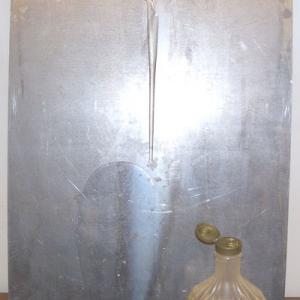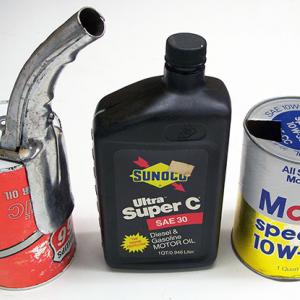College of Liberal Arts & Sciences
2C30.15 - Viscosity
Hold the metal plate up at an angle and pour some syrup on it near the top. Note how long it takes for the syrup to run down the plate compared to water or alcohol.
Clamp the large metal plate to the top of a table. Position the pulley so that a mass will be able to pull the small plate across the surface of the large plate without lifting the front of the small plate. Pour some glycerin onto the the large plate and spread it out so that the small plate will slide on a film of glycerin as it is being pulled. Add mass to the end of the string connected to the small plate until this plate moves with constant velocity. Measure how far the plate moves per unit of time.
- Sanjoy Kumar Pal, Pradipta Panchadhyayee, "Determining Viscosity of a Liquid with Smartphone Sensors: A Classroom-Friendly Approach Using Damped Oscillations", TPT, Vol. 63, #1, Jan. 2025, p. 64.
- Jose Costa Leme, Agostinho Oliveira, "Pendulum Underwater - An Approach for Quantifying Viscosity", TPT, Vol. 55, #9, Dec. 2017, p. 555.
- David Guerra, Kevin Corley, Paolo Giacometti, Eric Holland, Michael Humphreys, and Michael Nicotera, "An Introduction to Dimensionless Parameters in the Study of Viscous Fluid Flows", TPT, Vol. 49, #3, March 2011, p. 175.
- Federico M. Ortega, Osvaldo D. Pavioni, Hugo L. Dominguez, "A Communicating-Vessel Viscometer", TPT, Vol. 45, # 2, Feb. 2007, p. 116.
- Lewis Carrol, "Viscosity", TPT, Vol. 20, #1, Jan. 1982, p. 47 - 48.
- Alexandre Delvert, Pascal Panizza, Laurent Courbin, "Measuring the Viscosity of Air With Soapy Water, a Smartphone, A Funnel, and a Hose: An Experiment for Undergraduate Physics Students", AJP, Vol. 90, #1, Jan. 2022, p. 64.
- L. Courbin, G. Cristobal, M. Winckert, P. Panizza, "Erratum: 'Design of a Low Cost Zimm-Crothers Viscometer: From Theory to Experiment' [AJP, Vol. 73, # 9, 851-855, Sept. 2005]", AJP, Vol. 74, # 1, Jan. 2006.
- Rafael M. Digilov, M. Reiner, "Weight-controlled Capillary Viscometer", AJP, Vol. 73, # 11, Nov. 2005, p. 1020.
- L. Courbin, G. Cristobal, M. Winckert, and P. Panizza, "Design of a Low Cost Zimm-Crothers Viscometer: From Theory to Experiment", AJP, Vol. 73, # 9, Sept. 2005, p. 851.
- M. G. C. Peiris and K. Tennakone, "Simple Method for Determination of the Viscosity of a Liquid", AJP, Vol. 48, #6, June 1980, p. 497.
- E. M. Purcell, "Life at Low Reynolds Number", AJP, Vol. 45, # 1, Jan. 1977, p. 3.
- Amber Williams, "How Long Is The Longest Running Lab Experiment?", Popular Science, Feb. 2012, p. 72.
- Janice VanCleave, "Compare the Viscosity of Different Fluids", Super Science Challenges, p. 118.
- Johanna Miller, "Experiment Probes Pattern Formation During Debonding of Viscoelastic Adhesives", Physics Today, Oct. 2008, p. 22.
- Jearl Walker, "2.60, Bouncing Liquid Stream", The Flying Circus of Physics Ed. 2, p. 106.
- Jearl Walker, "2.62, Liquid Rope Coils", The Flying Circus of Physics Ed. 2, p. 107.
- Yaakov Kraftmakher, "7.6, Stokes Viscometer", Experiments and Demonstrations in Physics, ISBN 981-256-602-3, p. 453.
- W. Bolton, "Ostwald Viscometer", Book I - Properties of Materials, Physics Experiments and Projects, 1968, p. 19-20.
- W. Bolton, "The Viscosity of Engine Oils", Book I - Properties of Materials, Physics Experiments and Projects, 1968, p. 70 - 71.
- W. Bolton, "Boundary-Layer Lubrication", Book I - Properties of Materials, Physics Experiments and Projects, 1968, p. 78-79.
- Julius Sumner Miller, Q54 & A54, Millergrams I – Some Enchanting Questions for Enquiring Minds, p. 38 & 95.
Disclaimer: These demonstrations are provided only for illustrative use by persons affiliated with The University of Iowa and only under the direction of a trained instructor or physicist. The University of Iowa is not responsible for demonstrations performed by those using their own equipment or who choose to use this reference material for their own purpose. The demonstrations included here are within the public domain and can be found in materials contained in libraries, bookstores, and through electronic sources. Performing all or any portion of any of these demonstrations, with or without revisions not depicted here entails inherent risks. These risks include, without limitation, bodily injury (and possibly death), including risks to health that may be temporary or permanent and that may exacerbate a pre-existing medical condition; and property loss or damage. Anyone performing any part of these demonstrations, even with revisions, knowingly and voluntarily assumes all risks associated with them.


